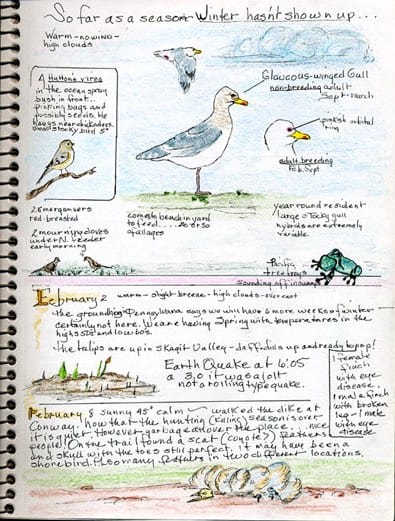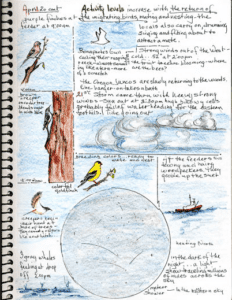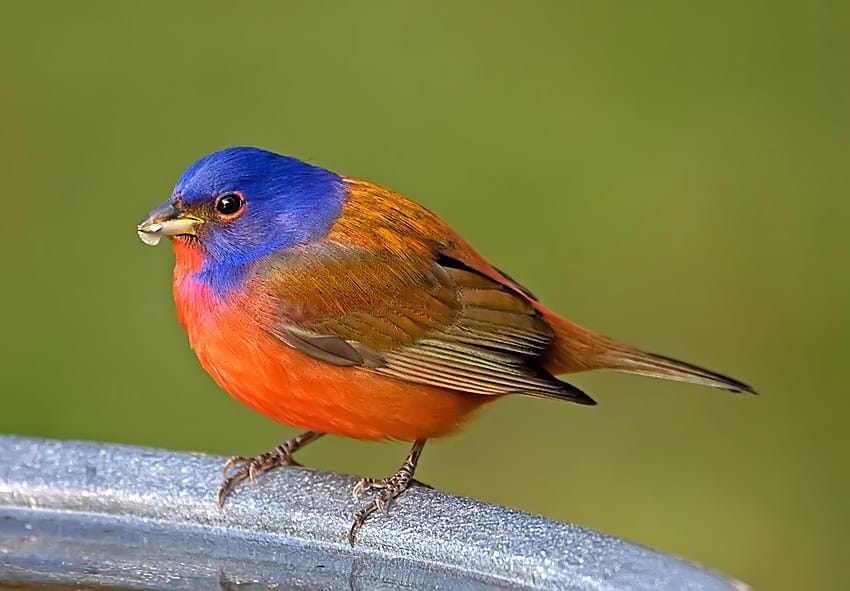It is said that the difference between a person who simply enjoys nature and a true naturalist is that a naturalist keeps a field journal. Amateur and professional bird watchers, artists, and philosophers have long kept such records of their thoughts and observations, but now an increasing number of regular folks are taking up the pastime of journaling.
Keeping a journal, regardless of our ultimate goal, helps us “see” more clearly and completely. Noting what you see in a journal makes your eyes active participants, requiring a visual judgment: What exactly am I seeing? How would I describe it – its color, texture, movement? What is it doing?
Journals versus Field Notes for Bird Watching
Although field notes and nature journals do overlap, they sometimes serve different purposes. The goal of keeping field notes is usually to document key points of your bird observations for the purpose of identification, data collection, or other purposes. Size, distinctive markings, habitual movements, unusual postures, voice, and flight behavior – all of which are critical in credibly documenting bird sightings – are typically captured in field notes. Journals, while often including some of the same types of observations as recorded in field notes, are intended to document the observer’s increasing personal understanding of the observed creatures – and of oneself.
The only discoveries that matter in a journal are personal. Our journal entries, for example, document the behaviors that species exhibit in the spring versus the fall, because we want to know more about how they live and what their life experiences are like. We also have many entries describing how individual birds relate to us, the observers.
While the field note resides in the realm of the scientist, the nature journal is a way to tap into the creative flow, to generate a meditative tranquillity through a creative act. But one need not be a professional scientist, philosopher, writer, or artist to keep a bird-watching journal: The benefits are the same for anybody who takes the time to observe and ponder the wonders of nature.
Journals are personal. It is entirely up to you what to include in your journal, and no one should tell you how to keep one. What follows are ideas that others have used – not rules.
Some Journaling Guidelines
- 1. If you are intimidated by your lack of writing ability, remember that you don’t need to share your journal with anyone if you don’t want to. You don’t even have to reread what you’ve written. The point of journaling is the activity itself. On the other hand, we strongly encourage you to make the nature journal a family entertainment and to share your work with other people who are keeping journals. You may even wish to start a journaling circle among your friends, and compare and discuss your observations over time. But if you do, set a ground rule at the beginning: You don’t have to be Hemingway to keep a worthwhile bird-watching journal.
- 2. Spelling and grammar don’t count – even for the kids. The quickest way to destroy the joy of creation is to demand perfection.
- 3. Try drawing some things. It doesn’t matter how they come out – though your attempts will surely get better over time if you stick with it.
- 4. Your journal can’t be ruined. It is a record of your learning experiences and failed experiments, and dead ends are part of learning. Crossed out words and imperfect drawings are found in the best of journals.
- 5. You don’t have to write in your journal every day. In fact, it’s best if you wait until you’re in the mood. But you probably want to keep your journal near the window by the bird feeder, because journaling can become addictive.
The Journal Keeper’s Tools
Start your journaling journey by assembling your supplies, and have fun collecting them. Keeping a journal need not be expensive. In fact, all those blank pages may intimidate you less if you use a less expensive book. We recommend the following items:
Blank books. Blank books (as opposed to lined notebooks) provide more flexibility if you decide to add sketches, leaf collections, or feathers. Choose a size that is comfortable to write in. If your children will be contributing, at least 8 x 11 is best. That way you will have plenty of room to glue in their artistic endeavors. It doesn’t matter whether the book is hard- or softcover, though you will need a hardcover or clipboard if you think you might take the book on nature hikes or walks through your neighborhood. Find a book with paper that has a smooth surface and is of reasonable quality – especially if you will be drawing in it or gluing things to it.
Pens and pencils. Some journal devotees have special pens that they use only with their journals, to make the act feel more like a special ritual. Using the same ink color over time for the main body of your writing will provide some visual consistency from entry to entry. You can use colored pens and pencils to highlight dates, draw fanciful borders, or punch up areas of text as your whims dictate. Or if you prefer simplicity, a disposable pen is just fine.
Art supplies as needed. Optional. Other supplies that might be helpful in your journal kit are art stamps, ink-pad, spray adhesive (for sticking pictures in your book), watercolors, kneaded eraser, ruler, scissors, and even stickers. It’s important that you have lots of fun collecting and using these items, so that you will be less inclined to abandon your journal once the novelty wears off.
The Basic Entry
The basic journal entry should contain the parts of the following that are important to you:
- The date.
- The location of your observations.
- The weather: high and low temperatures for the day (we consult our newspaper) and general weather conditions (sunny, raining, thunderstorms, snowing, windy). If you are a weather maven, you may want to include comments about cloud formations or observations that may indicate coming weather.
- What’s blooming: Document what has bloomed recently in your observation area. This may affect the types of birds you notice.
- The birds you observe and what they are doing.
Let your journal take you where it will. If you are insecure about writing paragraphs, make a few notations. Write lists. Call upon memories you had as a child. But above all, use all your senses.
If you see an interesting, colorful, beautiful, or otherwise noteworthy bird that you can’t identify, do try to capture some detailed information about it. Although you may be more of a philosopher than a scientist, you don’t want to miss the thrill of a rare bird sighting. Field guides include some helpful ideas on what to look for. In particular, record the following:
- Overall size.
- Color and size of the bill; color of the eyes, legs, and feet (if you can see them).
- Color and pattern of the plumage: include side of the head and neck, back, rump, tail (including size and shape), wings (wing bars present?), the underparts: chin, throat, breast, belly, and under the tail. Note any crests or ornamental feathers.
- Vocalizations: Use your own words to describe the call – not those of the field guides.
- Behavior: What is the bird doing? Is it feeding in flight or foraging in the foliage? Does it wag its tail or hold it in an unusual position (do you notice any other quirks)?
- Do a quick sketch if you can.
Journaling for Nonwriters
If you are not a writer, it is easy to become blocked before you even start. Facing a blank page can be stressful. One way to begin is to record your experience of what is happening at the moment. And to experience that moment, we need to let go of our self-consciousness.
One way to let go of self-consciousness is to use stream-of-consciousness writing. Don’t think, just write whatever comes to mind on the topic at hand. If you start straying from the subject (“The cardinal pair are at my feeder this morning. The male selects a seed, flies to the female below the feeder, and presents it to her. I really need to fill the birdfeeders this weekend”), gently bring yourself back by using one of your other senses (“There is still a chill in the air and the cardinal pair look fat in their fluffed feathers”).
Learning to See
A nature journal helps the heart and the mind reconnect with nature. As you record your observations, you are learning about how nature works. A journal can remind you when things happened (“I noticed that the male goldfinch was molting on September 12 last year. This year, the first molting male we saw was September 20”). They also may form the basis of how you feel about the world around you. You may be able to draw parallels to your own life and family and gain a better understanding of yourself in the process. Your notes can even help you use field guides to better effect by jogging your memory long after the observed bird has come and gone.
Laura Sewell, in her book Sight and Sensibility: The Ecopsychology of Perception, describes five ways of seeing beyond the surface of things.
- Learning to be mindful. What is really happening in the present?
- Perceiving depth. Using all your senses, you become part of what you observe.
- Seeing relationships and context. It is cold, so the cardinals are fluffed up to keep warm. The sparrows at the feeder seem to have a pecking order. The less dominant vacate their position when the more dominant arrive.
- Learning to see things that happen in time scales different from our own. Noting that the goldfinches molt according to a seasonal pattern.
- Observing with our imaginations. The birds at my feeder seem to have personalities and I can relate to them as individuals.
Try to use different ways of perceiving to stimulate and inspire your writing.
Illustrations for Nonartists
You don’t have to be an artist to create beautiful bird-watching journals. Although some people illustrate their journals with magnificent sketches or watercolors, there are many other ways to highlight and beautify your entries. There’s nothing wrong with a little well-earned pride in your journal.
Unique fonts and borders. Some people use colored markers or pencils to highlight the date or important passages. Try drawing in some of your text vertically or diagonally for variation. Some journal keepers draw fanciful borders around their pages or place text in circles. The key is to use your imagination.
Stamps. You can obtain decorative stamps and ink from any craft store to embellish your work, or you can have fun creating your own stamps from natural materials. For example, try pressing a leaf or feather on your stamp pad or brushing it with ink and pressing the item onto your journal page. We guarantee you’ll be pleased with the result.
Pressed leaves and flowers. Pressed leaves and flowers may be glued into your notebook with magical effect. If you prefer a journal that is a little less lumpy, scan flowers or leaves into your computer, print the results using a color printer, and glue the image onto your entry page. Try to use flowers or leaves that are important to the birds that you are observing, or that remind you of a particular moment.
Photos. A regular or digital photograph can really enhance your observations. Be sure to describe the action and location in the caption. Birds rarely sit still very long, so make sure your camera is always close at hand.
Drawings. Sketching has long been the preferred means to illustrate a journal. It is low tech, inexpensive, and immediate. Your childrens’ drawings of their observations may be some of the most rewarding pictures in your book. And perhaps your child’s lack of self-consciousness as an artist will inspire you to take a few chances with your own artwork. Feel free to use a pencil, pen, felt-tip pen, crayon, colored pencil, or whatever you feel comfortable with. One thing is certain: The more often you take a stab at drawing what you observe or imagine, the better you will become at drawing, observing, and imagining.
Keeping a birding journal will make your interactions with nature more rewarding. It can be a relaxing, even meditative process. And it will give you something to do with all those blank books.
Alan and Linda Zuckerman are writers who live in White Hall, Maryland.







This is a great article for someone interested in getting started with a birding journal. I love how you emphasized that keeping a journal is not about skill or even about being extremely precise, but instead its about documenting a personal experience. Very encouraging!
Very helpful article, thank you!!